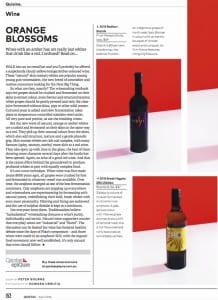
Orange wines are amongst us, inc the BH ZBO.
Qantas Inflight magazine recommends the Brash ZBO Zibibbo in its April edition. Written by wine writer Peter Bourne, the article explores the “Orange” wine craze which is sweeping the nation. Orange wines are white wines made like reds, meaning the skins stay in the fermenter a lot longer than normal to make wines with more tannin and complexity than your usual dry, clear white wine. And they become amber in hue with a little more oxygen exposure and longer contact with the pigment of the grape skins. Our Zibibbo, for example, is left on skins for 180 days, which is highly unusual, but makes for a very intriguing, delicious glass of wine.
As Mr Bourne says: “Zibibbo is a clone of muscat fermented on its skins in an amphora. A pale apricot colour with intense grapy aromas and a whiff of almond meal, this is full flavoured and richly textured yet remarkably spritely.”
The entire piece, and Quisine section, is here on p.152 http://www.qantas.com/infodetail/flying/inTheAir/inflightMagazine/quisine.pdf
Or here:
Orange Blossoms
Wines with an amber hue are really just whites
that drink like a red. Confused? Read on…
WALK into an on-trend bar and you’ll probably be offered
a suspiciously cloudy yellow/orange/amber-coloured wine.
These “natural” skin-contact whites are popular among
young-gun winemakers, the new breed of sommelier and
restless consumers looking for the Next Big Thing.
So what are they, exactly? The winemaking textbook
says red grapes should be crushed and fermented on their
skins to extract colour, more favour and structural tannins;
white grapes should be gently pressed and only the clear
juice fermented without skins, pips or other solid matter.
Cultured yeast is added and slow fermentation takes
place in temperature-controlled stainless-steel tanks.
All very pure and precise, as are the resulting wines.
But the new wave of natural, orange or amber whites
are crushed and fermented on their skins in the same way
as a red. They pick up their unusual colour from the skins,
which also add structure, texture and a gentle phenolic
grip. Skin-contact whites are rich and complex, with many
favours (spicy, savoury, earthy) more akin to a red wine.
They also open up with time in the glass, the best of them
showing more character several days after the bottle has
been opened. Again, an echo of a good red wine. And that
is the raison d’être behind the groundswell to produce
profound whites to pair with equally complex food.
It’s not a new technique. When wine was first made
(some 8000 years ago), all grapes were crushed by foot
and fermented in whatever vessel was available. Over
time, the amphora emerged as one of the best fermentation
containers. Clay amphoras are popping up everywhere
and winemakers are experimenting by fermenting with
natural yeasts, embellishing their bold, brash whites with
even more personality. Filtering and fining are eschewed
and the use of sulphur dioxide is kept to a minimum.
Not everyone loves them. Traditionalists believe
“lackadaisical” winemaking obscures a wine’s purity,
individuality and terroir. Natural-wine supporters counter
that everyday wines are “industrial” and “bland”. The
discussion can be heated but wine has fostered healthy
debate since the days of Plato’s symposium – and those
wines were made in an amphora! Still, with the organic
food movement now well established, it’s only natural
that wine should follow.
STORY BY PETER B O U R N E
PHOTOGRAPHY BY EDWARD URRUTIA
